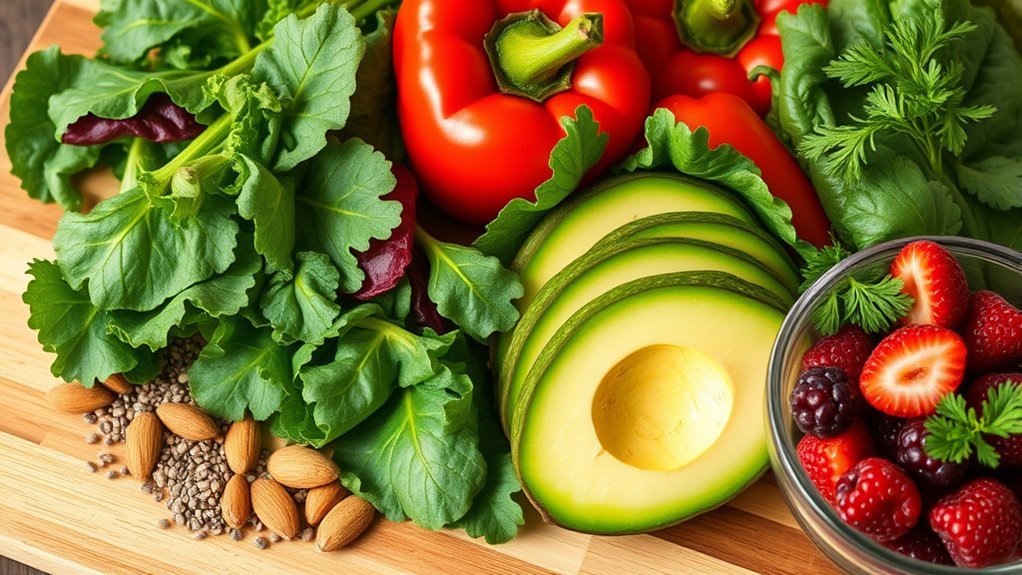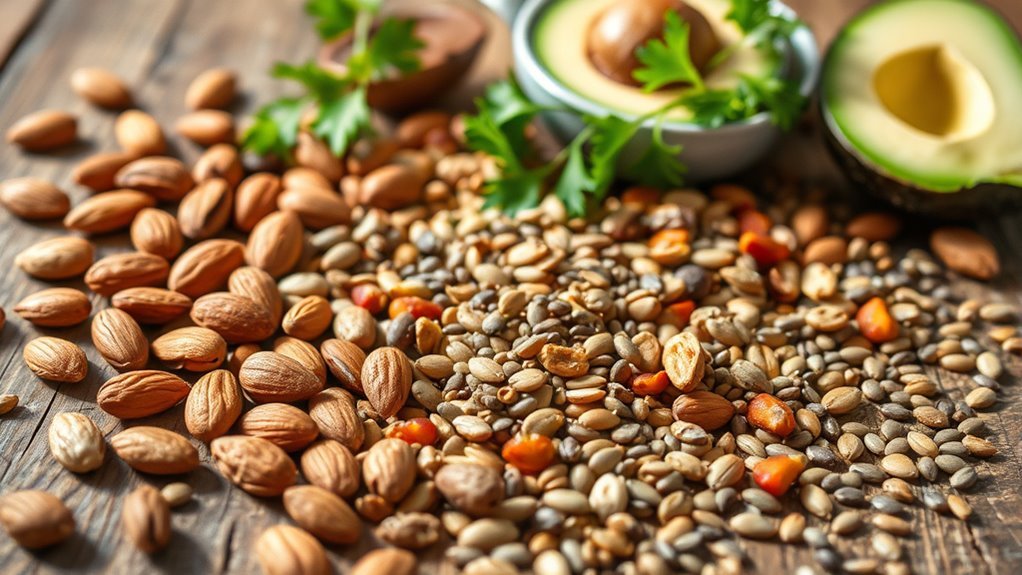To get more fiber on a keto diet, focus on low-carb vegetables like spinach, broccoli, and Brussels sprouts. Incorporate nuts and seeds, especially almonds and chia seeds, for a crunchy fiber boost. Don’t forget to add avocados for healthy fats and fiber. Psyllium husk and flaxseed are excellent options for baking or smoothies. Staying hydrated is essential for digestive health, too. You’ll discover more strategies to enhance your fiber intake and support your keto lifestyle.
Understanding Fiber and Its Importance on Keto

While you might think of fiber as just another nutrient, it plays an essential role in maintaining overall health, especially on a ketogenic diet. There are two primary fiber types: soluble and insoluble. Soluble fiber helps manage blood sugar levels and supports heart health, while insoluble fiber aids in digestion by promoting regular bowel movements. On keto, where carb intake is limited, it’s vital to prioritize fiber-rich foods to enhance digestive health. Incorporating foods like avocados, chia seeds, and nuts can guarantee you meet your fiber needs without exceeding your carb limit. By understanding the importance of fiber and choosing the right types, you can enjoy the freedom of a keto lifestyle while keeping your digestive system functioning at its best.
Low-Carb Vegetables That Pack a Fiber Punch

When you’re on a keto diet, incorporating low-carb vegetables can greatly boost your fiber intake. Some top fiber-rich options include leafy greens, broccoli, and Brussels sprouts, which not only support digestion but also keep you feeling full. By adding these veggies to your meals, you’re not just meeting your fiber needs; you’re enhancing flavor and nutrition as well.
Top Fiber-Rich Vegetables
Incorporating fiber-rich vegetables into your keto diet can considerably enhance your overall health without compromising your carb intake. Some top low-carb options include spinach, kale, broccoli, and cauliflower. These vegetables not only boost fiber absorption but also provide essential nutrients. Combining them creatively can maximize their benefits; for instance, try mixing spinach with avocado or tossing broccoli in olive oil for added flavor. Zucchini and asparagus are also great choices, offering a satisfying crunch while keeping carbs low. By including these fiber-rich vegetables in your meals, you’ll not only feel fuller longer but also support digestion and overall wellness. Embrace these veggie combinations to liberate your meals and nourish your body effectively!
Incorporating Veggies in Meals
To make the most of your keto meals, adding low-carb vegetables that are high in fiber can greatly enhance both texture and nutritional value. Think about incorporating veggie combinations in your meal prep, like spinach and zucchini for salads or broccoli and cauliflower in stir fry options. Roasting techniques can bring out the natural sweetness of veggies, making them perfect for toppings on grilled meats or in soup recipes. You can also blend leafy greens into smoothie recipes for a fiber boost without sacrificing flavor. Experiment with grilling methods, or try innovative salad ideas for a revitalizing crunch, ensuring each meal is not only filling but also packed with fiber and flavor enhancement. Enjoy the freedom of creativity in your cooking!
Nuts and Seeds: Crunchy Sources of Fiber

Nuts and seeds are not just tasty snacks; they’re also excellent sources of fiber that fit perfectly into a keto diet. Almonds, chia seeds, and flaxseeds are among the top options that can help you boost your fiber intake. Incorporating these crunchy additions can enhance your meals while keeping your carb count low.
Top Fiber-Rich Nuts
When it comes to boosting your fiber intake on a keto diet, crunchy options like nuts and seeds can make a significant difference. Some nut varieties are particularly rich in fiber, offering not just nutritional benefits but also tasty snack ideas. Here are some top fiber-rich nuts to take into account:
- Almonds: Packed with about 3.5 grams of fiber per ounce, they’re great for snacking.
- Pistachios: With around 3 grams of fiber, they’re delicious and easy to munch on.
- Hazelnuts: Offering about 2.7 grams of fiber, they’re perfect for adding crunch to dishes.
- Walnuts: Containing about 2 grams of fiber, they provide a rich, buttery flavor.
- Pecans: With 2.7 grams of fiber, they’re a sweet addition to many recipes.
Incorporating these into your diet can enhance your fiber content and overall health benefits.
Beneficial Seed Options
While you might think of nuts as the primary source of crunch on a keto diet, seeds also offer a fantastic way to boost your fiber intake. Packed with nutrients, these tiny powerhouses can be easily incorporated into your meals. Here are some beneficial seed options to contemplate:
| Seed Type | Fiber Content (per 100g) |
|---|---|
| Chia Seeds | 34g |
| Flax Seeds | 27g |
| Pumpkin Seeds | 18g |
You can sprinkle chia seeds on yogurt, add hemp hearts to smoothies, or munch on pumpkin and sunflower seeds as snacks. Don’t forget sesame seeds for added crunch in salads. By diversifying your seed choices, you’ll enjoy more fiber freedom on your keto journey!
Incorporating Avocados: A Keto Superfood
Avocados are not just a creamy addition to your meals; they’re a powerful source of fiber that fits perfectly into a keto diet. Packed with healthy fats, they offer numerous avocado benefits while keeping your carb intake low. Including avocados in your meals can enhance your fiber intake considerably. Here are some ideas to enjoy them:
Avocados are a creamy, fiber-rich addition to your keto meals, packed with healthy fats and low in carbs.
- Sliced avocado atop a fresh salad
- Creamy guacamole recipes as a dip for veggies
- Blended into smoothies for a rich texture
- Added to omelets for a delicious breakfast
- Mixed into your favorite keto-friendly desserts
The Benefits of Psyllium Husk and Flaxseed
In addition to avocados, incorporating psyllium husk and flaxseed into your keto diet can markedly boost your fiber intake. Psyllium husk is a soluble fiber that promotes digestive health, helping to maintain regularity and prevent constipation. The psyllium benefits extend to potential cholesterol reduction, making it a heart-healthy choice. On the other hand, flaxseed nutrition shines with its rich omega-3 fatty acids and lignans, which may support weight loss and reduce inflammation. By adding these two ingredients to your meals, you’ll not only enhance your fiber consumption but also enjoy their numerous health perks. Whether in smoothies, baked goods, or sprinkled on salads, these fibers offer a practical way to stay healthy while embracing your keto lifestyle.
Creative Ways to Use Coconut Flour
Coconut flour is a versatile ingredient that can elevate your keto cooking in numerous ways. With its high fiber content, it’s perfect for creating delicious, low-carb coconut flour recipes. Here are some creative uses to contemplate:
- Pancakes that are fluffy and satisfying
- Breadsticks for a perfect dipping experience
- Muffins loaded with flavor and texture
- Thickening agent for soups or sauces
- A base for keto-friendly pizza crusts
Incorporating coconut flour into your meals not only adds unique flavors but also offers coconut flour benefits, like improved digestion and increased satiety. So, release your creativity in the kitchen and enjoy the freedom of delicious, fiber-rich keto meals!
Exploring Fiber-Rich Keto Snacks
Are you looking for tasty ways to boost your fiber intake while staying keto? Discovering fiber-rich keto snacks can be both enjoyable and satisfying. Here are some keto snack ideas that can help you reach your fiber goals:
| Snack | Fiber Content (g) | Notes |
|---|---|---|
| Chia Seed Pudding | 10 | Great as a fiber-rich dessert |
| Avocado Slices | 7 | Packed with healthy fats |
| Celery with Almond Butter | 5 | Crunchy and filling |
These options not only keep you on track but also add variety to your diet. Don’t forget to experiment with fiber-rich desserts like coconut flour brownies or flaxseed cookies to satisfy your sweet tooth while adhering to your keto lifestyle!
Staying Hydrated: The Role of Water in Digestive Health
While many people focus on food choices for digestive health, staying properly hydrated is equally essential. Proper hydration supports digestive balance, helping fiber do its job effectively. Here are some hydration tips to keep in mind:
Proper hydration is crucial for digestive health, ensuring fiber works effectively and supporting overall digestive balance.
- Drink water consistently throughout the day.
- Add lemon or cucumber slices for flavor and nutrients.
- Include herbal teas as a soothing option.
- Consume water-rich foods like cucumbers and watermelon.
- Consider electrolyte-rich drinks, especially after exercise.
Frequently Asked Questions
Can I Take Fiber Supplements on a Keto Diet?
Yes, you can definitely take fiber supplements on a keto diet. They can help you meet your fiber needs, especially if you’re struggling to find fiber sources that fit your low-carb lifestyle. Popular supplement types include psyllium husk, inulin, and chia seeds, which can all support digestive health. Just be sure to choose low-carb options and watch your intake, as too much fiber too quickly can lead to digestive discomfort.
What Are the Signs of Fiber Deficiency on Keto?
You might not realize it, but signs of fiber deficiency can sneak up on you. If you’re experiencing digestive issues like bloating, constipation, or irregular bowel movements, these could be fiber symptoms. You may also feel fatigued or notice changes in appetite. It’s essential to listen to your body; incorporating more fiber can help alleviate these issues and support your overall health while enjoying the freedom of your keto lifestyle.
How Does Fiber Affect Ketosis?
Fiber affects ketosis primarily by supporting digestive health and stabilizing blood sugar levels. While it’s not directly involved in ketone production, soluble and insoluble fiber types can help you feel full, reducing cravings for carbs. This can enhance ketosis benefits, like improved energy and mental clarity. Incorporating fiber-rich, low-carb foods guarantees you maintain a healthy gut while enjoying the freedom that keto offers, allowing you to thrive without feeling deprived.
Can I Eat Too Much Fiber on Keto?
Yes, you can eat too much fiber on keto. While fiber sources like leafy greens and nuts are great, excessive fiber can lead to digestive issues, such as bloating or gas. It’s crucial to maintain a fiber balance, ensuring you get enough without overdoing it. Aim for about 25 grams of fiber daily, focusing on low-carb options. Listen to your body, and adjust your intake if you experience discomfort. Enjoy your keto journey!
Are There Any Side Effects of High Fiber Intake on Keto?
While fiber’s often hailed as a digestive hero, too much can lead to some uncomfortable experiences. You might find yourself facing digestive discomfort or bloating issues, especially if your body’s not used to high fiber levels. It’s important to increase your intake gradually, allowing your system to adjust. Staying hydrated can also help ease these side effects, giving you the freedom to enjoy the benefits of fiber without the unwanted consequences.


